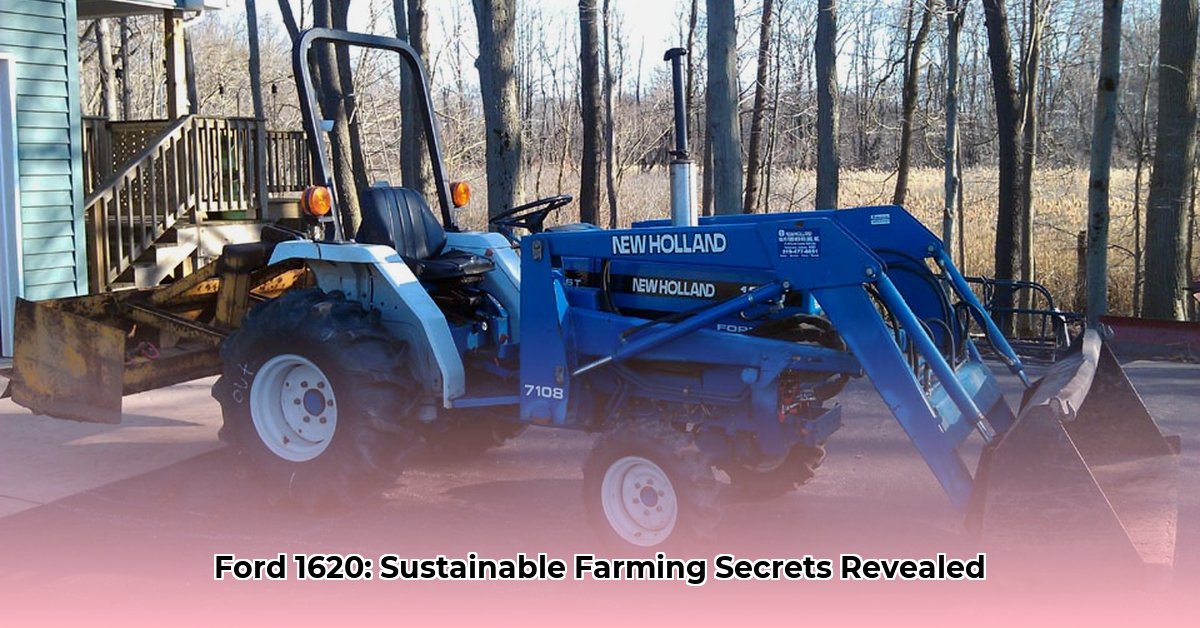
The Ford 1620: A detailed review for the modern, eco-conscious farmer. Is this compact tractor the right fit for your sustainable farming operation? Let's delve into its capabilities, challenges, and overall suitability. For information on battery options, see this helpful resource.
Power and Performance: A Small Tractor, Big Capabilities
The Ford 1620, despite its age, offers surprising power for its size. Its 26-horsepower engine and 22-horsepower PTO (power take-off – the shaft that powers implements like mowers) handle numerous small farm tasks with ease. Mowing, tilling, and operating various implements are all within its capabilities. The hydrostatic transmission (a system that uses hydraulic fluid to control speed and direction) is a standout feature; it's smooth, efficient, and remarkably easy to operate. While a new Ford 1620 around 1997 cost approximately $17,000, used models offer a potentially affordable entry point for budget-conscious farmers. But is the lower initial cost offset by higher maintenance? Let's explore.
Fuel Efficiency: Economic and Environmental Benefits
While precise fuel consumption figures for older tractors are elusive, the Ford 1620's 7.1-gallon fuel tank suggests relatively efficient operation. Three-cylinder diesel engines are generally known for their fuel economy. This translates directly to lower operational costs – a significant advantage for sustainable farming. Moreover, fuel efficiency can be further enhanced through smart driving techniques and the exploration of biodiesel as a more sustainable alternative fuel. How can you maximize fuel efficiency and minimize your environmental impact?
Parts, Maintenance, and Mechanic Availability: The Challenges of Ownership
The reality of owning an older tractor must be addressed. Finding parts for a Ford 1620 can be challenging; availability is often limited, potentially leading to increased downtime and higher repair costs. Securing a reliable mechanic familiar with this model may also prove difficult. Thorough pre-purchase inspections and a realistic assessment of potential maintenance costs are therefore crucial. What steps can you take to mitigate these challenges?
Versatility and Adaptability: A Multi-Functional Asset
The Ford 1620’s versatility is a major asset. Its ability to accommodate various implements (mower decks, snowblowers, etc.) makes it a multi-functional tool, minimizing the need for specialized equipment. This directly contributes to more sustainable practices by reducing both capital expenditure and the environmental footprint associated with owning a fleet of individual machines. Is the Ford 1620's flexibility worth considering for your needs?
Sustainability in Practice: Long-Term Considerations
The Ford 1620's compact size minimizes soil compaction, a significant advantage compared to larger tractors. Its fuel efficiency reduces the environmental impact of farming operations. However, we need to consider the entire life cycle of the tractor, including its eventual disposal and the continued reliance on fossil fuels, even with biodiesel use. Ongoing research into alternative fuels and sustainable farming technologies will continually shape our approach to agricultural equipment. Are you prepared to carefully consider the environmental aspects of this tractor's lifetime?
Actionable Steps for Key Stakeholders
Let's outline practical steps for different stakeholders:
Small-Scale Farmers: Conduct thorough inspections; engage a trusted mechanic; budget for repairs and parts; plan for future replacement; research alternative fuels; implement regular preventative maintenance.
Equipment Dealers: Stock key parts; train mechanics; partner with manufacturers of sustainable equipment; offer specialized maintenance and repair services for the 1620.
Agricultural Researchers: Benchmark the Ford 1620 against modern counterparts; research potential upgrades for improved fuel efficiency and alternative fuel compatibility; study effective maintenance schedules.
Risk Assessment Matrix
| Risk Factor | Likelihood | Impact | Mitigation |
|---|---|---|---|
| Parts Availability | High | High | Develop relationships with specialized suppliers; maintain a stockpile of common parts. |
| Maintenance Costs | Medium | Medium | Preventative maintenance; find a reputable mechanic; budget for unforeseen repairs. |
| Fuel Costs | Medium | Medium | Efficient driving techniques; explore alternative fuels; monitor fuel prices. |
| Environmental Impact | Low | Low | Responsible disposal at end of life; fuel-efficient operating practices. |
| Tractor Obsolescence | High | High | Financial planning for replacement; consider resale value. |
Regulatory Compliance
Ensure compliance with all local regulations concerning older farm machinery, including safety features like ROPS (Roll Over Protective Structure). Staying updated on relevant laws is crucial for responsible operation.
The Ford 1620 offers a compelling case for sustainable, small-scale farming. However, its age requires careful consideration. Weighing its strengths against its weaknesses, combined with strategic planning, will help determine if this tractor is the correct choice for your farming needs.